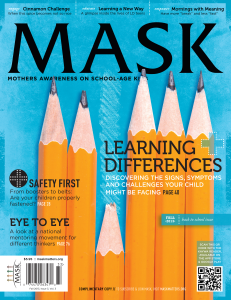
The Evolution of Tobacco
February 28, 2024
Establishing Good Food and Fitness Habits for Your Child
March 4, 2024Diagnosing learning differences in elementary years involves a collaborative approach between parents, teachers, and educational professionals.
Here are some steps that can be taken:
- Observation and Identification:
- Teachers and parents should observe the child’s behavior, academic performance, and social interactions.
- Identify any consistent patterns of difficulty, such as struggles with reading, writing, math, or attention.
- Communication:
- Maintain open communication between parents and teachers to share observations and concerns.
- Discuss the child’s performance in various subjects and their behavior in the classroom.
- Teacher Input:
- Teachers play a crucial role in identifying learning differences. They can provide insights into the child’s behavior, engagement, and performance in the classroom.
- Request a meeting with the teacher to discuss any concerns and gather their input.
- Specialized Assessments:
- Consult with the school’s special education team or a learning support specialist.
- Request specialized assessments, which may include cognitive assessments, educational assessments, and behavioral assessments.
- Parental Involvement:
- Work closely with parents to gather information about the child’s development, both inside and outside the classroom.
- Discuss any family history of learning differences or developmental issues.
- Collaboration with Specialists:
- If needed, collaborate with specialists such as psychologists, speech therapists, or occupational therapists to assess specific areas of concern.
- Individualized Education Plan (IEP):
- If a learning difference is identified, collaborate with the school to develop an Individualized Education Plan (IEP).
- The IEP outlines specific goals, accommodations, and support services tailored to the child’s needs.
- Continuous Monitoring and Adjustments:
- Regularly monitor the child’s progress and make adjustments to the learning plan as needed.
- Maintain ongoing communication between parents, teachers, and specialists.
- Advocacy:
- Advocate for the child’s needs within the school system. This may involve attending meetings, participating in the development of the IEP, and ensuring that the necessary accommodations are in place.
- Supportive Environment:
- Create a supportive learning environment that addresses the child’s unique needs and encourages their strengths.
Remember that early intervention is key in addressing learning differences, and a collaborative approach involving various stakeholders can lead to effective support for the child.
Grab the Learning Difference Issue of MASK The Magazine and learn how to help your child.
MASK The Magazine is the parenting manual offering solutions to the modern-day challenges families face. Each quarterly issue of the award-winning MASK The Magazine tackles a specific topic in-depth and examines how it can affect kids from Pre-kindergarten to College.
Add these single issues of MASK The Magazine. Create your own MASK Library of information to turn to when these issues come up in your family. Educate and empower your family with the information and solutions to handle the topics MASK addresses.
You’ll learn age-appropriate conversation starters which can help open the lines of communication between you and your child(ren). MASK The Magazine is packed with advice and will prepare and equip you with knowledge, resources and skills to help strengthen parent-child bonds.
MASK the Magazine content is evergreen as it is written based on the “core” topics and strategies. Ships only in the United States.
To learn more about MASK The Magazine



